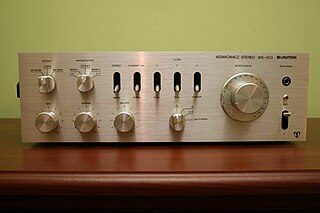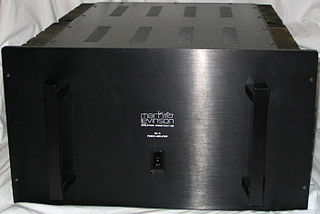 W
WAn audio power amplifier is an electronic amplifier that amplifies low-power electronic audio signals such as the signal from radio receiver or electric guitar pickup to a level that is high enough for driving loudspeakers or headphones. Audio power amplifiers are found in all manner of sound systems including sound reinforcement, public address and home audio systems and musical instrument amplifiers like guitar amplifiers. It is the final electronic stage in a typical audio playback chain before the signal is sent to the loudspeakers.
 W
WBi-amping and tri-amping is the practice of using two or three audio amplifiers to amplify different audio frequency ranges, with the amplified signals being routed to different speaker drivers, such as woofers, subwoofers and tweeters. Biamping can be done with a single power amplifier if the device has more than one amplifier, as the case with a stereo power amp. Triamping cannot be done with a stereo power amp; a mono power amp would need to be added or a home theatre receiver could be used. With bi-amping and tri-amping, an audio crossover is used to divide a sound signal into different frequency ranges, each of which is then separately amplified and routed to separate loudspeaker drivers. In some bass amplifiers using bi-amping, the woofer and horn-loaded tweeter are in the same speaker enclosure. In some bi-amp set-ups, the drivers are in separate speaker enclosures, such as with home stereos that contain two speakers and a separate subwoofer.
 W
WThe carbon microphone, also known as carbon button microphone, button microphone, or carbon transmitter, is a type of microphone, a transducer that converts sound to an electrical audio signal. It consists of two metal plates separated by granules of carbon. One plate is very thin and faces toward the speaking person, acting as a diaphragm. Sound waves striking the diaphragm cause it to vibrate, exerting a varying pressure on the granules, which in turn changes the electrical resistance between the plates. Higher pressure lowers the resistance as the granules are pushed closer together. A steady direct current is passed between the plates through the granules. The varying resistance results in a modulation of the current, creating a varying electric current that reproduces the varying pressure of the sound wave. In telephony, this undulating current is directly passed through the telephone wires to the central office. In public address systems it is amplified by an audio amplifier. The frequency response of most carbon microphones, however, are limited to a narrow range, and the device produces significant electrical noise.
 W
WA CMoy is a pocket headphone amplifier originally designed by Pow Chu Moy
 W
WA class-D amplifier or switching amplifier is an electronic amplifier in which the amplifying devices operate as electronic switches, and not as linear gain devices as in other amplifiers. They operate by rapidly switching back and forth between the supply rails, being fed by a modulator using pulse width, pulse density, or related techniques to encode the audio input into a pulse train. The audio escapes through a simple low-pass filter into the loudspeaker. The high-frequency pulses are blocked. Since the pairs of output transistors are never conducting at the same time, there is no other path for current flow apart from the low-pass filter/loudspeaker. For this reason, efficiency can exceed 90%.
 W
WGainclone or chipamp is a type of audio amplifier made by do-it-yourselfers, or individuals interested in DIY audio. It is a design based on high-power integrated circuits, particularly the National Semiconductor Overture series. The Gainclone is probably the most commonly built and well-known amplifier project amongst hobbyists. It is simple to build and involves only a few readily accessible, inexpensive parts. As an amplifier it is highly regarded by many in the DIY community.
 W
WA headphone amplifier is a low-powered audio amplifier designed particularly to drive headphones worn on or in the ears, instead of loudspeakers in speaker enclosures. Most commonly, headphone amplifiers are found embedded in electronic devices that have a headphone jack, such as integrated amplifiers, portable music players, and televisions. However, standalone units are used, especially in audiophile markets and in professional audio applications, such as music studios. Headphone amplifiers are available in consumer-grade models used by hi-fi enthusiasts and audiophiles and professional audio models, which are used in recording studios.
 W
WThe Mark Levinson ML-3 was a 200 watt per channel dual monaural Class AB2 power amplifier that used toroidal transformers. Produced between 1979 and 1987, the ML-3 consisted of two electrically separate amplifiers in one chassis, hence the name "Dual Monaural". It also featured discrete circuit construction; no integrated circuits were incorporated to keep the signal pure. The design was by Thomas P. Colangelo.
 W
WThe MC-2300 is a solid-state power amplifier which was built by the American high-end audio company McIntosh, and sold between the years 1971 and 1980. It can be utilized either as a 300-watt-per-channel stereo amp, or a 600-watt monoblock, and was rated by its manufacturer as being able to produce this amount of power continuously, with very little distortion. McIntosh's ratings were conservative, however, because like many of their amplifiers, when bench-tested the MC-2300 has frequently been found to produce an even higher level of clean power.
 W
WA megaphone, speaking-trumpet, bullhorn, blowhorn, or loudhailer is usually a portable or hand-held, cone-shaped acoustic horn used to amplify a person's voice or other sounds and direct it in a given direction. The sound is introduced into the narrow end of the megaphone, by holding it up to the face and speaking into it, and the sound waves radiate out the wide end. A megaphone increases the volume of sound by increasing the acoustic impedance seen by the vocal cords, matching the impedance of the vocal cords to the air, so that more sound power is radiated. It also serves to direct the sound waves in the direction the horn is pointing. It somewhat distorts the sound of the voice because the frequency response of the megaphone is greater at higher sound frequencies.
 W
WThe NAD 3020 is a stereo integrated amplifier by NAD Electronics, considered to be one of the most important components in the history of high fidelity audio. Launched in 1978, this highly affordable product delivered a good quality sound, which acquired a reputation as an audiophile amplifier of exceptional value. By 1998, the NAD 3020 had become the most well known and best-selling audio amplifier in history.
 W
WNaim Audio is a specialist British manufacturer of high-end audio amplifiers well known for their self described qualities of "pace, rhythm and timing".
 W
WThe Naim NAIT is an integrated amplifier from the British hi-fi manufacturer, Naim Audio. The original NAIT is one of the most recognisable pieces of hi-fi equipment ever made. Hi-fi critic Lucio Cadeddu recognised its legendary status, referring to it as "one of the most controversial and famous integrated amps in the history of HiFi".
 W
WThe TRM-800 was a Hi-End solid state integrated stereo amplifier made in Japan, using NEC power transistors, by Nikko. It was the top of the line model in the Nikko amplifier range of TRM's series; beautifully housed in a wooden walnut-finished cabinet and a handsome brushed aluminum front panel, was introduced in 1975 the same year as the Marantz 2235. It was a 2 channel amp; however, it had three sets of speaker connections; those powered selected by buttons. At 8 ohms, the amp could put out 65 Watts per channel RMS, delivering superb high fidelity sound with exceptional tone quality. Unlike many amps of this time, however, the TRM-800 was stable at lower impedances than 8 ohms; down to 4 ohms. The TRM-800's frequency response ranges 10Hz to 40.000 Hz ±1 dB with T.H.D. less than 0.1% at rated output. Its preamplifier and main amplifier were separable for multi-channel amplifier systems. The amp has internal circuit breakers which prevent it from clipping or overheating. Its power consumption is 250 watts. For equalization it has only a bass and a treble knob; however the frequency of these are selectable; between 250 and 500 Hertz for the bass, and between 2.5 and 5 kHz for the treble. It also has a high, low, and a subsonic filter. There are two excellent phono stages; phono 2 is provided with impedance matching selection, for using different types of cartridges (MC/MM).
 W
WRCF S.p.A. is a widely recognized Italian manufacturer of high performance audio products including power amplifiers, loudspeakers, digital mixers and digital signal processors (DSP).
 W
WThe Sansui AU-11000 is a home audio integrated amplifier built by Japanese audio electronics manufacturer Sansui during the mid 1970s. The amplifier is known across the audiophile community for its high-output power and low Total harmonic distortion (THD).
 W
WA single-ended triode (SET) is a vacuum tube electronic amplifier that uses a single triode to produce an output, in contrast to a push-pull amplifier which uses a pair of devices with antiphase inputs to generate an output with the wanted signals added and the distortion components subtracted. Single-ended amplifiers normally operate in Class A; push-pull amplifiers can also operate in Classes AB or B without excessive net distortion, due to cancellation.
 W
WA sound reinforcement system is the combination of microphones, signal processors, amplifiers, and loudspeakers in enclosures all controlled by a mixing console that makes live or pre-recorded sounds louder and may also distribute those sounds to a larger or more distant audience. In many situations, a sound reinforcement system is also used to enhance or alter the sound of the sources on the stage, typically by using electronic effects, such as reverb, as opposed to simply amplifying the sources unaltered.
 W
WClass T was a registered trademark for a switching (class-D) audio amplifier, used for Tripath's amplifier technologies. Similar designs have now been widely adopted by different manufacturers.
 W
WTube sound is the characteristic sound associated with a vacuum tube amplifier, a vacuum tube-based audio amplifier. At first, the concept of tube sound did not exist, because practically all electronic amplification of audio signals was done with vacuum tubes and other comparable methods were not known or used. After introduction of solid state amplifiers, tube sound appeared as the logical complement of transistor sound, which had some negative connotations due to crossover distortion in early transistor amplifiers. The audible significance of tube amplification on audio signals is a subject of continuing debate among audio enthusiasts.
 W
W W
W